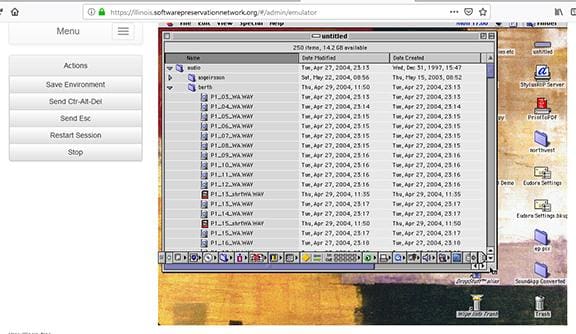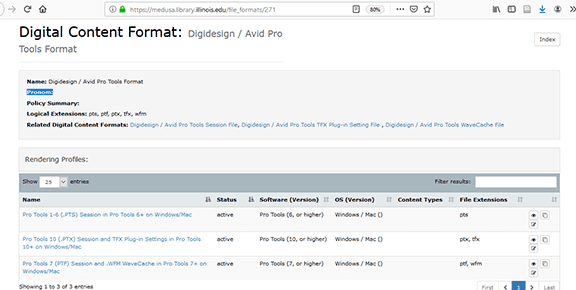Staff from the University Library at the University of Illinois Urbana-Champaign joined the “Fostering a Community of Practice: Software Preservation” cohort for the opportunity to focus on continued development on preservation of and access to born digital collections held in our special collections. The FCoP project has facilitated piloting emulation and software preservation practice at our institution and engagement with emulation and software preservation on a community level. This priority elevation through a project grant is particularly important within the broad landscape of a large R1 academic institution where digital preservation activities are often competing for resources among multiple, concurrent priorities.
Specifically, our project focus is on preserving, improving discovery of and providing access to files created by contemporary music composers. We are interested in further investigation and development of emulated environments where proprietary digital audio recording and production, and music notation software can run in as close to a native environment as possible to render this class of files, which often include complex digital objects representing container or project files comprised of several dependent files. In most of the audio production or composition context, recorded output is not enough to demonstrate the creative context. The archivist responsible for these collections equates rendering born digital music production and composition files to having access to a composer’s notebook, where a researcher may gain additional information about what creative choices were made when composing or producing audio works. From a service point of view we are interested in scaling this work to meet the needs of future collections of composers’ and other born digital collections with consideration of available resources.
Our initial project scope centered on three composers born-digital collections. Each collection presents different curation challenges and levels of contextual information provided collections. The file creation dates within the collections span from 1992 – 2012, representing a significant expanse of time in terms of technological development and software versions. I quickly realized that this scope of work was too ambitious for the time and resources available or found that some instances would not be well served through the emulation tool and its current limitations.
We scaled our efforts back to concentrate on processing the born-digital content from two collections: the Michael Manion Music and Papers recovered from a Macintosh PowerBook 3400c, manufactured circa 1997, and the Peter Michalove collection representing content extracted from a PC laptop running Windows 7. Currently, we have an Emulation-as-a-Service-Infrastructure (EaaSI) environment which was created from a forensic .E01 disk image of the PowerBook hard drive.

I am currently using this disk image and the EaaSI environment as a processing area to gain greater intellectual control of the content, reviewing the software installed within the creation environment, rendering the files in their native software, paying particular attention to files that do not have a file extension or program association when exported from the native environment, identifying where there are hardware dependencies and other settings idiosyncratic to this composer and his working environment. I am also remaining mindful of file and software properties which could be generalizable and considered significant when assessing similar files in the future, and am endeavoring to document these properties in our digital content format registry, which is a locally developed knowledgebase used to document significant properties and rendering profiles for challenging born digital content held in our collections.

I also created an EaaSI environment running Windows 7 and Sibelius score writing software in order to access select files from the Peter Michalove collection. In addition to the Windows laptop, this collection arrived with a file inventory created by Peter Michalove, which provided guidance for focused curation efforts. I was able to extract Sibelius files from the inventory into a subset of files. The subset maintained the source file directory structure, thus maintaining some semblance of original order and context.
In the examples above, I considered questions one might ask in deciding when to use emulation. Although EaaSI provides support of some aspects of the technical platform for emulation and provides excellent resources for getting started with adding emulation to workflows, there is still local work centered on policies, procedures and workflow which require commitment and engagement, particularly in a distributed environment such as the University Library here at Illinois. Working in a centralized point servicing all the library requires that I think about managing these projects to scale.
Much of my work within the FCoP project has been centered on formalizing and scaling workflows. Most of the methods used within the scope of the project were in various stages of development prior to the project. However, involvement in the project has emphasized the importance of formalizing these steps in continuing to build access capabilities and scaling the work to explicitly identify roles and tasks. This project has also underscored the challenges of managing upward and advocating in an environment where there are multiple competing priorities and ever fewer resources. Over the course of the FCoP project and due to varying staffing changes and other local major projects, staff on the project team began to peel away and became less involved over time. An implicit local project outcome is advocating for more staffing resources through demonstrating what additional preservation and access might look like if we have more resources to dedicate to processing and curation.
Overall, the FCoP cohort experience has been invaluable. It has been refreshing to connect on a regular basis with colleagues encountering similar challenges, and to champion one another through as we each engage in our respective projects. The cohort model will also benefit the greater SPN community through our unique perspectives, expertise gained, and documentation generated to support practical engagement with emulation and software preservation. I’m grateful for the support and camaraderie of all engaged with FCoP, EaaSI and SPN!